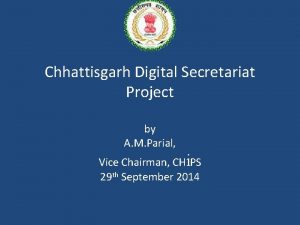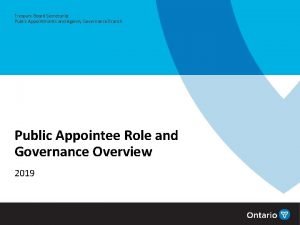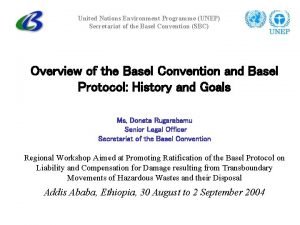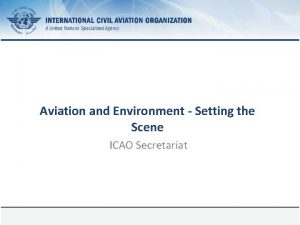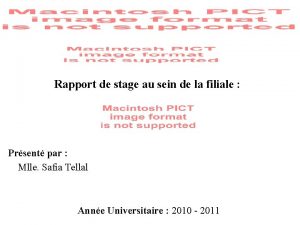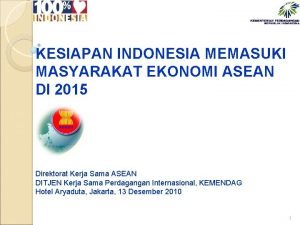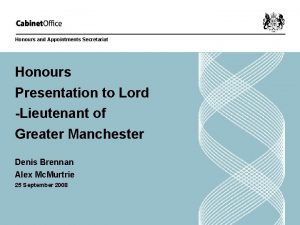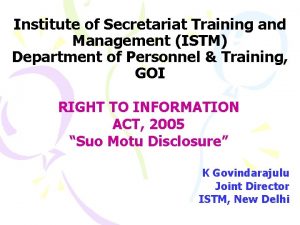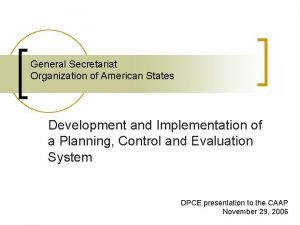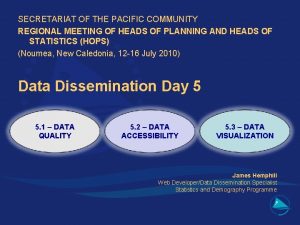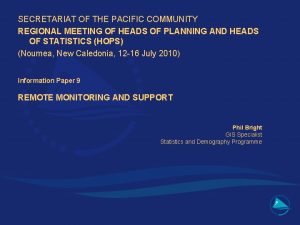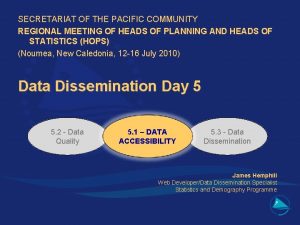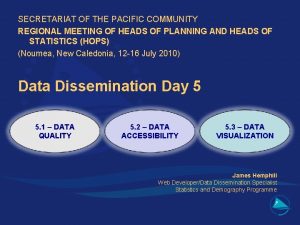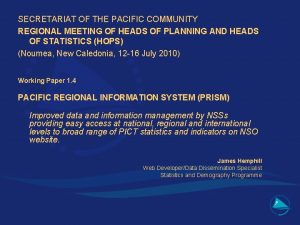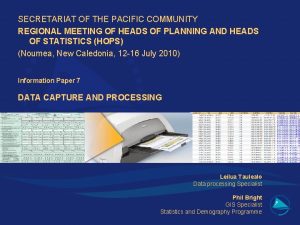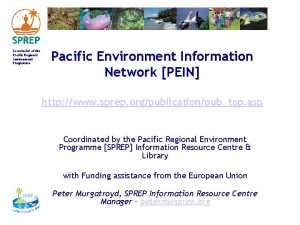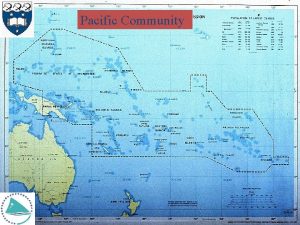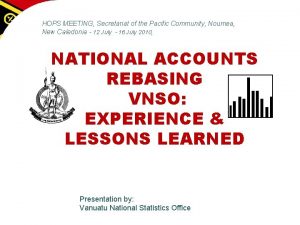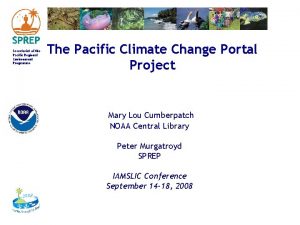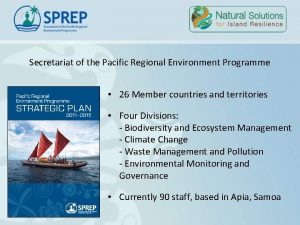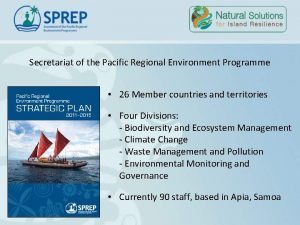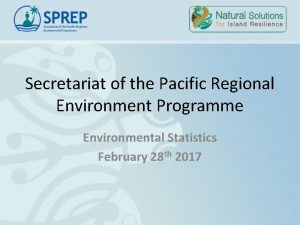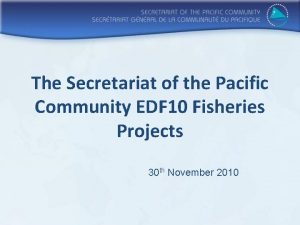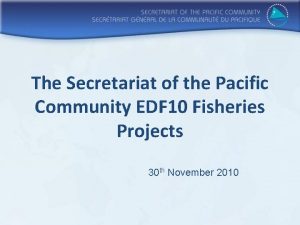SECRETARIAT OF THE PACIFIC COMMUNITY REGIONAL MEETING OF























- Slides: 23

SECRETARIAT OF THE PACIFIC COMMUNITY REGIONAL MEETING OF HEADS OF PLANNING AND HEADS OF STATISTICS (HOPS) (Noumea, New Caledonia, 12 -16 July 2010) Data Dissemination Day 5 5. 1 – DATA QUALITY 5. 2 – DATA ACCESSIBILITY 5. 3 – DATA VISUALIZATION James Hemphill Web Developer/Data Dissemination Specialist Statistics and Demography Programme

Data Dissemination The flow of Quality to Visualization 1 Communication Collaboration 5. 1 – DATA QUALITY Regional Workshops Fieldwork Face-to-face Project Planning Regional Standards 5. 2 – DATA ACCESSIBILITY 2 Technology Web Publishing Geographical Information Systems IT Strengthening Software needs Internet Availability 5. 3 – DATA VISUALIZATION

Data Dissemination The flow of Quality to Visualization The relevance of statistical information reflects the degree to which it meets the real needs of users. The accuracy of statistical information is the degree to which the information correctly describes the phenomena it was designed to measure. The interpretability of statistical information reflects the availability of the supplementary information and metadata necessary to interpret and utilize it appropriately. Metadata: an Integral Part of Statistics Canada’s Data Quality Framework - Marcelle Dion, Statistics Canada

Data Dissemination The flow of Quality to Visualization The timeliness of statistical information refers to the delay between the collection point to the point where it becomes available. The timeliness of information will influence its relevance. The accessibility of statistical information refers to the ease with which it can be obtained by users. The coherence of statistical information reflects the degree to which it can be successfully brought together with other statistical information. Metadata: an Integral Part of Statistics Canada’s Data Quality Framework - Marcelle Dion, Statistics Canada

Data Dissemination The flow of Quality to Visualization

Data Dissemination The flow of Quality to Visualization “On their own, statistics are just numbers…To mean anything, their value to the person in the street must be brought to life. ” Making Data Meaningful Part 1 – 2009 United Nations Commission for Europe “What cannot be measured cannot be administered - So measure all you can measure and what you cannot measure make it measurable” Galileo Galilei 1564 -1642; Philosopher.

SECRETARIAT OF THE PACIFIC COMMUNITY REGIONAL MEETING OF HEADS OF PLANNING AND HEADS OF STATISTICS (HOPS) (Noumea, New Caledonia, 12 -16 July 2010) Data Dissemination Day 5 5. 1 - DATA QUALITY 5. 2 - Data Accessibility 5. 3 - Data Dissemination James Hemphill Web Developer/Data Dissemination Specialist Statistics and Demography Programme

Data Quality July 16 th 8. 45 - 9. 30 Session 5. 1 Pacific DATA QUALITY Improvements is techniques and processes for data collection and data processing 2007 -2010 Importance of metadata, documentation and microdata 2010 -2013 activities to further enhance quality – Discuss…

Review of Day 3 Advances in Techniques and Processes o Commitment by national authorities to statistics development through adequate funding to NSOs o Restructuring NSOs and ensuring highly qualified personnel are recruited, retained and adequately remunerated o Strengthening statistical legislation to ensure compliance by all data providers o Enhanced access and full utilization of administrative data sources.

Review of Day 4 Advances in Techniques and Processes o Training - the biggest time savers in census data processing would come from getting things correct as much as possible in the field. o Field-work supervision - Important to emphasize that training field staff MUST be complimented by fieldwork supervision, otherwise the overall objective is lost. o The use of satellite imagery and GPS to better assist with field work – for example enumerator maps can be used to determine areas which were missed - exact completeness/covereage of EAs. NOTE: Advances in technology should not drive the process. Emphasis should be placed on the basics, with most of the errors being caught at the start of a collection

Review of Day 4 Advances in Techniques and Processes Technology can have an indirect effect: Scanning STAFF TRAINING FIELD-WORK SUPERVISION Skype DATA QUALITY Imagery GPS DATA GAPS

2010 -2013 Discussion on the way forward to enhance Data Quality Assurance – Involve Subject Matter Specialists as much as possible to verify reports, publications and the data itself. Collaboration between countries and other agencies – Communication is key. Concentrate on Capacity Building in order to enhance quality and set up a good base for data dissemination

Microdata Management and Metadata/Documentation Project IHSN – World Bank – Paris 21 – SPC – Pacific NSOs Preservation of data Documentation Dissemination

Decision-making and insights From data to knowledge And wisdom Feedback Loop Knowledge and wisdom Synthesis Information Data and statistics that have been transformed through analysis Microdata Organized data (statistics) Aggregations -Tables -Time series Data collection: Censuses Surveys Polls Administrative processes The world we live in Analysis Selection Planning & data collection

Metadata and Data Archiving The data documentation, or metadata, helps the researcher to: • find the data they are interested in. • understand what the data are measuring and how the data have been created. • assess the quality of the data.

Microdata Management and Metadata/Documentation Project Requirement to focus on data utilization at the 2005 HOPS Meeting. Combined with a lack of centralized archives of data and metadata and noted that metadata was poor or did not exist. There is an increasing demand for access to Microdata by data users as it is an important input to evidenced-based decision making and policy development. Unit Record ‘Raw’ Data

Why? Training and Capacity Building in Documentation • Data documentation serves several important functions. It helps data producers (NSOs) build institutional memory, researchers to help find the data they are interested in by making it easier to locate the datasets and variables that meet their research requirements • users understand what the data are measuring and how they data have been created, and assess their quality; and it gives background on the survey design and the methods used when collecting and processing the data, thereby reducing the risk that data will be misunderstood or misused.

Why? Data preservation and development of a survey catalog • Statistical datasets are fragile and their long term availability to users is not always maintained. Micro-datasets can be damaged or lost because of human error, because of technical problems, or because of disasters such as fire or flood. • New technologies can also render old data unreadable, because of either hardware or software advances. Datasets must be properly archived to ensure they will be available for use the future.

What? Training and Capacity Building in Documentation 1. 2. 3. 4. 5. 6. Survey Documentation Dataset Variable Documentation External Resources Export to a variety of formats Disseminate to CD-ROM Disseminate to Web

How? Data Dissemination • Data dissemination increases the use and potential impact of data, by: § § § Making it possible for analytical work to be replicated. Creating the potential to use old data to test new ideas. Reducing the costs of data collection and the burden on respondents, by avoiding the need for researchers to undertake their own surveys. Demonstrating transparency and credibility in data production, which are at the heart of good governance. Improving the relevance and quality of data by incorporating user’s feedback in future data collection.

http: //www. vanuatustats. com/vanuatustats/nada/ Dissemination via data catalog

Dissemination to Web http: //prismstats. com/index. php? option=com_ content&view=article&id=4&Itemid=3

Discussion • What type of requests for microdata are the NSO recieiving? • The need for documentation of recent household surveys and censuses • Develop data catalog archive documented census/survey datasets on NSO website and CD-Rom • Possibility to make Microdata from recent survey and censuses available to researchers particularly Pacific Island Students from USP • Discuss the need for an official data access and protection policy for microdata sets
 Pacific island forum secretariat
Pacific island forum secretariat Rcsu pacific
Rcsu pacific Gsvc.org
Gsvc.org Cg digital secretariat
Cg digital secretariat Honours secretariat
Honours secretariat Public appointments secretariat
Public appointments secretariat Unep secretariat
Unep secretariat Agri benchmark
Agri benchmark Secretariat scene
Secretariat scene Secretariat family tree
Secretariat family tree Rapport de stage exemple
Rapport de stage exemple Trans kalahari corridor secretariat
Trans kalahari corridor secretariat Literacy and numeracy secretariat
Literacy and numeracy secretariat Asean secretariat
Asean secretariat Honours and appointments secretariat
Honours and appointments secretariat Cites secretariat
Cites secretariat Institute of secretariat training and management
Institute of secretariat training and management General secretariat for development planning
General secretariat for development planning Today meeting or today's meeting
Today meeting or today's meeting Today meeting or today's meeting
Today meeting or today's meeting What is meeting and types of meeting
What is meeting and types of meeting Types of meeting
Types of meeting Tỉ lệ cơ thể trẻ em
Tỉ lệ cơ thể trẻ em Lời thề hippocrates
Lời thề hippocrates



